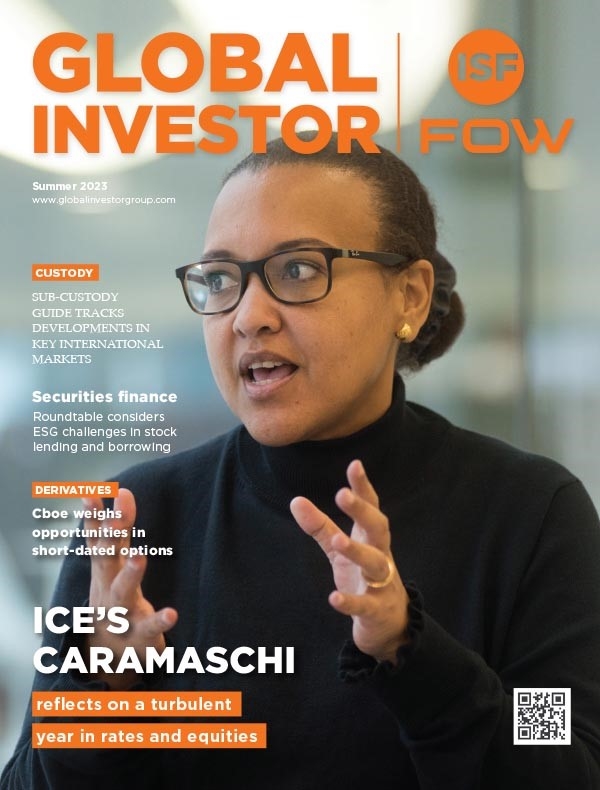Citi: Collateral management and the buy-side: a growing concern?
| PARTICIPANTS: Guy Usher, Head of Derivatives and Structured Finance, Field Fisher Waterhouse Nick Newport, Managing Director, InteDelta Mark Ryan, Derivatives and Counterparty Risk Manager, Aviva Investors Tim Harris, Associate Director, Alternatives and Derivatives, Hermes Fund Managers Roger Fishwick, Chief Risk Officer, Thomas Murray Data Services Rajen Shah – Global Head of Collateral Management & Emea Head of Securities Finance, Citi |
Guy, can you start by laying out the current collateral requirements arising from the new rules on OTC derivatives?
Guy Usher: Taking the margin requirements as presented in the latest BCBS-Iosco report, both what is required and the timeline for compliance are generally manageable due to the proposed thresholds and phasing. Significantly, much of the impact in the early stage will be around variation margin and not – as we had first thought – initial margin. This will have considerable knock-on effects.
Funds will be judged as financial counterparties, and will thereby be covered by variation margin requirements irrespective of trade volumes. This will have significant implications for prime brokers, which will inevitably mean they will look to pass the costs associated with two-way variation margin on to customers.
Mark Ryan: But these issues will not hold up implementation – there is so much political pressure to implement these measures that it would be unwise to assume that the timelines will be pushed back.
How will these new collateral requirements affect buy-side firms?
Tim Harris: A lot will depend on the type of fund. Typical fixed income, credit or equity portfolios – in comparison to real estate portfolios or pension funds – will face very different challenges under the new rules. In general, we have lots of ideas about how to address the challenges, but we have not put them into practice yet.
Current priorities – notably reporting requirements – are more pressing. I think that in three to four months time we will start to focus more heavily on this and look to advice from external parties.
Mark: Whether through initial or variation margin, it is clear that the cumulative effect of the new rules will be that we will be posting far more margin in three or four years than we are today. That is going to have a number of consequences.
For example, getting from where we are today, with collateral posting often operating with a two-day settlement period to a place where clearing houses are demanding collateral intraday, is a big job. But if you do not want to build up big cash buffers, which will drag on performance, collateral will have to be far better optimised.
How important will pension funds be in providing the high-quality collateral needed by other participants for central clearing?
Roger Fishwick: Pension funds will only engage in the transformation trade if they are rewarded for the risks, since lending government bonds and taking in equity collateral is not going to help their risk profile. Insurers, another potential source of this collateral, are reluctant to be involved because Solvency II would punish them for the inferior collateral they would be left with.
In terms of pricing, therefore, the 102 or 105 pricing model for this type of collateral seems too low. The formula has been around for years so is unlikely to have a statistical basis – an uplift to 120 or 125 could be more realistic. In addition, the agent lender must continue to provide indemnification.
What progress are buy-side firms making in ensuring they are optimising the sourcing of collateral from within their portfolios?
Tim: Full end-to-end collateral optimisation is still something of a utopia and remains grounded in the back office. When we get into clearing in 2014 the CCPs will begin to differentiate themselves with how they can support it.
The outsource providers and custodians are developing systems that will enhance our view on where our collateral is and where we may be able to optimise, but they do not yet integrate perfectly into our front-end platforms. It is still a black box scenario now but this will change – we are now having these conversations with our outsource providers and custodians more and more.
Mark: Currently we typically just use cash – when you want to use securities the plumbing involved gets much more difficult. Portfolio managers are reluctant to have too much of their time taken up with the logistics of recalling securities before they sell them. Our systems will need to improve in the future to make this a more seamless process.
What might a future optimisation solution look like for an illiquid portfolio like a real estate fund?
Tim: The basic scenario seems to be building a buffer and modelling the biggest market move that this could absorb before the portfolio had to be changed. Then, typically looking to the repo market for generating cash and eligible assets to meet the variation margin and/or initial margin.
We have concerns of course about the performance impact and about the repo market – notably whether we can get access to it in times of a stressed market. We are still not totally clear about how such a portfolio would generate the cash or assets to meet margin requirements without adapting.
This means we are starting to look at alternative OTCs or non-OTC products to gain the required exposure – structured note type products in the case of real estate, for example. There is not a one-size-fits-all solution and some portfolios will need to change more than others.
What are other people hearing from buy-side clients in terms of demand relating to optimisation?
Nick Newport: Both terms – transformation and optimisation – can mean different things to different participants. Most participants are aware that they will need to improve the process by which they select and deliver collateral. But the main challenge will be for funds that do not have a significant cash allocation and must raise collateral from their assets in other ways.
Rajen Shah: Up to now there has not been demand for these services. But this is changing. We and our competitors are developing the optimisation solutions required to automate these processes for clients. These solutions vary depending on the client’s needs. At one end would be an index-based fund that needs to identify where their assets are globally and how to move them to the CCP.
At the other – more complex – end, a fund would need access to a range of parameters that affect how best to source collateral. Where a fund has collateral that is of a higher quality than that required for the trade, it may be able to lend out this collateral, thereby receiving both the eligible collateral it needs and additional revenue. In other cases it may be that the costs of sourcing collateral for a trade makes it uneconomic and an alternative investment strategy needs to be explored.
Guy: Is anyone seeing interest from major institutional clients in aggregating all their collateral centrally by pulling it back from their investment managers so that they can control it themselves?
Raj: On a recent trip to Australia I found fund managers for the first time talking about doing this centrally. Outsource providers should be able to deliver here. Because our product is custodian-agnostic we can see the entire daily inventory of a client, instruct what has to be moved and send the instructions to the custodians.
At what point would it become appealing for buy-side firms to post less-eligible assets – corporate bonds and even equities – at CCPs, accepting punitively large haircuts, instead of using securities finance desks to provide more eligible assets, which can be posted with smaller haircuts?
Mark: While it might be useful to use this route sometimes, where it is more efficient to take a smaller haircut using the provider route we would hope to take that route. But, again, we would need the collateral management team to be sophisticated enough to seek out those anomalies. In general it is worth noting that we are keen for CCPs to keep acceptable collateral as tight as possible to limit the risk we face with them.
Tim: I agree that it is a concern that CCPs may widen the pool of eligible collateral to win business – some, for example, have suggested this route along with offering transformation and repo services. We would certainly be wary of engaging with these extended offerings at this point in time. We will look at the portfolios on a case-by-case basis.
Roger: On the question of concentration risk it is worth noting that the risk profiles of the different CCPs differ considerably, as our risk analysis of the 26 major CCPs – such as LCH.Clearnet – has shown. I am not sure that people are fully aware of the significant differences between them.
How well suited to outsourcing is the type of collateral management needed to meet the new margin requirements?
Tim: Providing collateral management services will be an important business for outsource providers. Most will likely combine it with their existing custody service and the internal securities lending businesses, placing optimisation on top of these existing services, as Rajen has described.
We have a mentality of outsourcing, so naturally we would look to these providers first for solutions– if they can offer a service then it would certainly be of interest to us.
| Conclusion: Current regulations make it likely that some funds will face a collateral squeeze: the need for optimisation and transformation solutions continues to be one of the key themes being debated. The overall cost of adhering to the new regulations is the other topic that concerns most buy-side institutions. Will the cost simply make it uneconomical to collateralise the OTCs a fund trades? Could this lead to a fund having to change its trading strategy? Given these costs will ultimately impact the value of the fund, portfolio managers should take heed. The operations of many buy-side institutions are now fully engaged and are evaluating options ranging from shifting to exchangetraded derivatives to collateral optimisation and transformation. Many view collateral management as an important but non-core function and are seeking solutions and services from the outsourcing providers in order to benefit from industrial strength and scale solutions that integrate custody, lending, clearing and collateral management to achieve greater efficiency in the selection, transformation, settlement and recall of collateral assets. |
Found this useful?
Take a complimentary trial of the FOW Marketing Intelligence Platform – the comprehensive source of news and analysis across the buy- and sell- side.
Gain access to:
- A single source of in-depth news, insight and analysis across Asset Management, Securities Finance, Custody, Fund Services and Derivatives
- Our interactive database, optimized to enable you to summarise data and build graphs outlining market activity
- Exclusive whitepapers, supplements and industry analysis curated and published by Futures & Options World
- Breaking news, daily and weekly alerts on the markets most relevant to you



